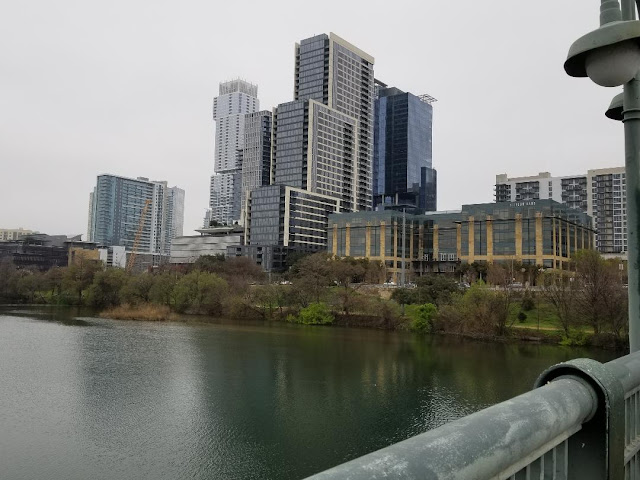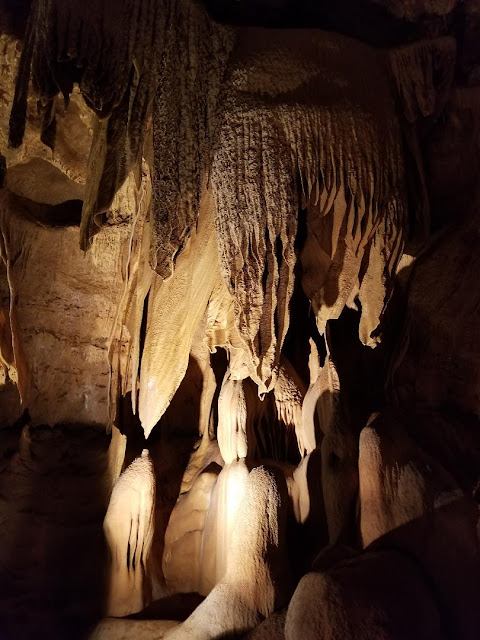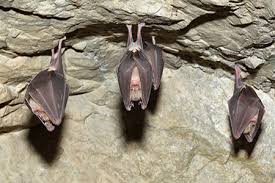Exploring Bat Maternity Centers
We have a problem with bats. Actually, bats have a problem with us. We
need bats because they are necessary for plentiful crops and our food supply. A
bat eats 3000 bugs per night and the things they eat – mosquitos, larvae,
worms, and other bugs - are harmful to crops and humans. Losing one bat is
significant, but we are losing millions.
Due to global warming bats are migrating north
earlier every year. Too early for their food supply, insects, to be either
hatched or large enough to sustain them. Later In the summer, when the insect
population Is highest, there are fewer bats.
The bat/insect ratio is out of balance.
If bat arrival continues to be out of sync with the hatching of crop
pests, there will be dire consequences for farmers and our food supply.
While exploring caves in Texas, New Mexico and
Arizona over the past month we learned a lot about bats and their importance to
the environment and people.
Extraordinary care is taken to protect bats living in these caves. When the bats inhabit the caves, they are off
limits to people. If you are wearing
shoes that have been in other caves within the past 10 years, the shoes must be
cleaned with alcohol. This is done to
prevent contaminating the cave with a fungus that causes "White Nose
Syndrome." WNS occurs when the
fungus grows on the nose of the bat and causes enough irritation to interrupt
hibernation. The constant awakening throughout
the winter causes the bat to use up its fat stores before winter is over. The bats die of malnutrition.
After spending January and February in Alabama
we went to Austin, Texas. Austin has an RV park right downtown (weird, I know)
that is ancient and run-down but had the amenities we needed and made most
things we wanted to see within walking distance. We enjoyed the farmers’
market- bought local pecans - and the Lady Bird Johnson Park by the river.
Steve fixed Indian food for a niece and her husband and son who live nearby.
 |
| Downtown Austin, Texas |
 |
| Downtown Austin park |
 |
| Old tree in the park. |
 |
| This is the ancient RV park in Downtown Austin and we bought smoked pecans from the farmers' market |
 |
| Yes, some one has been living here for a long time. It has electricity! |
 |
| Fun to see family! |
While in Austin we spent a day at the Lyndon B.
Johnson Presidential Library. This is the third Presidential library we have visited. Each has provided excellent history lessons
and reminded us of the many traumatic times our country has survived. What's going on today isn't too bad by comparison. We shall survive.
We were reminded of Lady Bird Johnson’s efforts
to clean up our highways and parks from litter and signage and trash. Those efforts did not take root in much of
west Texas. I've never seen so much
discarded plastic being blown by the wind.
If there wasn't oil under the ground this part of the US would be
desolate. I'm amazed that we fought a
war with Mexico to steal this land.
 |
| Replica of LBJ's oval office |
 |
| My mom collected tea cups and saucers just like Lady Bird did. |
 |
| Lady Bird's office |
I was not a happy camper during our few days in
southern New Mexico because the climate in New Mexico this time around was not
pleasant. First, it was cold and second everything, including the sky, was gray
and brown. And third, we were in the windstorm called the Bomb Cyclone that was
devastating the mid-West. Being in an RV
when the wind blows hard is scary.
The whole thing shakes and the canvas toppers (covers for the slides)
flap violently. To prevent the wind from
tearing the toppers off the coach we pulled in the slides and lived in a much
smaller motorhome. Just to add to the
mood, there was a tornado warning. If
the tornado had been close by, we could not have seen it through the rain or
heard it above the 60-mph wind.
It was my fault that we were in New Mexico
again. I wanted to see Carlsbad Caverns as I had heard my parents talk about
it. They had visited it in the early 50’s. Last year we missed it because its
elevators were under repair and climbing up 750 feet by stairs did not appeal
to us.
Carlsbad Caverns are huge. The Big Room, which
is larger than 2 US Capital buildings put together is awe-inspiring. By the time
we were finished, we had walked nearly 4 miles.
And there was more to explore if you were willing to climb, crawl,
wriggle through tight spaces and get dirty.
At Carlsbad there is an amphitheater at the
entrance. In the summer, people will sit
there at sunset to watch thousands of bats exit the cave to feed. One bat will
eat 3000 bugs per night.
In Arizona we went to see the Kartchner Caverns
in the Kartchner State Park. It’s prettier here because of the hills nearby and
the mountains in the distance. Kartchner Caverns is much smaller than Carlsbad
but beautiful and worth seeing if you are in the area. The cave was discovered by Randy Tuffs. When
he was a young boy Randy saw a hole in the side of a hill that he thought might
lead to a cave, but he didn't explore it at that time. He came back with his
college roommate seven years later and they went into the hole. They found a
smaller hole where air was blowing out (there was a low-pressure weather system
coming through) and they knew it meant there was a larger space below. They
enlarged the hole from grapefruit size to just large enough to squeeze through. They wanted to prevent the general public
from destroying the cave, so they kept it secret for 4 years, coming back to
eventually explore 2 ½ miles of the cave.
The cave was in land belonging to the Kartchner
family. Mr. Kartchner was 86 years old when they told him about the cave. He
even went down into it to see why they were excited. He had 12 children and
they had 10-12 children each, so he had 94 grandchildren!! And they all kept it
secret. Eventually they sold the land to the Arizona State Park so it could be
preserved and opened to the public. 37 million dollars were spent over 10 years
getting it ready viewing. The park has
a very nice Visitor’s Center, educational programs and videos. Walkways with handrails were built to make
visiting the cave safe and to protect it.
The cave is alive as the various formations within the cave are still
growing. Multiple doors throughout the
cave protect its wet, humid environment from the dry desert air. If the cave dries out it will die. It's fascinating to realize that there are
surely undiscovered caves all over the world. It is like another world below us
waiting to be discovered.
At Kartchner Caves there is one area of the
cave that is closed to the public from April to October to protect the bats who
are there to have their babies and raise their young. They also clean your
shoes with alcohol before entering in order to prevent “white nose disease”, the
disease that is killing bats.
The bats in the southern U.S. spend the winter
in South America. Then they come north to have their babies. They hang upside
down and birth “pups” that are about an inch long -which would be like humans
birthing 3-year-old toddlers. We could see their “maternity center” in the
Kartchner Caverns. There were also piles of black guano that does not smell
because they are insect eating bats. Fruit eating bats evidently have a bad
smelling guano.
It’s been a “batty” time.













Comments
Post a Comment